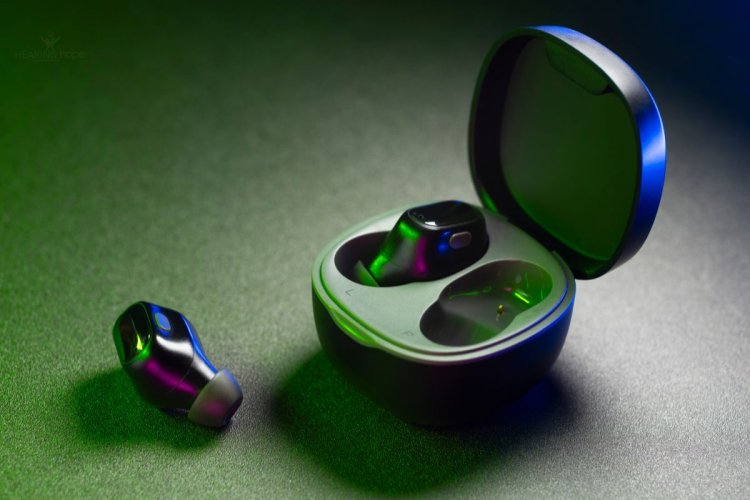How to Extend the Battery Life of Your Bluetooth Hearing Aid
Bluetooth hearing aids not only provide clear sound quality but also offer the convenience of modern technology without the constant worry of battery depletion.
Share this Post to earn Money ( Upto ₹100 per 1000 Views )
Bluetooth hearing aids have revolutionized the way individuals with hearing loss experience the world, offering seamless connectivity to smartphones, tablets, and other Bluetooth-enabled devices. However, with this advanced technology comes the responsibility of managing battery life effectively. Maximizing the battery life of your Bluetooth hearing aid not only ensures uninterrupted usage but also reduces the frequency of battery replacements or recharges, ultimately saving you time and money.
In this comprehensive guide, we’ll explore the factors that impact the battery life of your Bluetooth hearing aid and provide practical tips to extend it.
Understanding Bluetooth Hearing Aid Battery Life
Before diving into the strategies to extend battery life, it’s important to understand the factors that influence how long your hearing aid’s battery lasts. The battery life of a Bluetooth hearing aid is affected by several variables:
-
Bluetooth Usage: The more frequently you use Bluetooth connectivity for streaming music, phone calls, or other audio, the quicker your battery will drain.
-
Battery Type: Bluetooth hearing aids typically use either disposable zinc-air batteries or rechargeable lithium-ion batteries. The type of battery you use can significantly impact overall battery life.
-
Hearing Aid Settings: Features like noise reduction, volume control, and environmental adaptation require more power, which can drain the battery faster.
-
Daily Usage: The amount of time you wear your hearing aid each day directly correlates with how quickly the battery depletes.
-
Environmental Factors: Temperature and humidity can also affect battery performance, with extreme conditions potentially shortening battery life.
Tips to Extend the Battery Life of Your Bluetooth Hearing Aid
Now that we understand the factors that influence battery life, let's explore actionable tips to help you maximize the life of your Bluetooth hearing aid's battery.
Optimize Bluetooth Usage
While Bluetooth connectivity is one of the most significant advantages of modern hearing aids, it’s also one of the primary drains on battery life. To extend your battery life:
-
Limit Streaming: Use Bluetooth for essential functions like phone calls and minimize streaming music or other media. If you often stream, consider investing in hearing aids with longer battery life or additional portable chargers.
-
Disconnect When Not in Use: When you’re not using Bluetooth features, disconnect the hearing aid from your device. This prevents unnecessary battery drain.
-
Use Mono Audio: If you’re using Bluetooth for phone calls or audio streaming, consider switching to mono audio instead of stereo. This can reduce battery consumption.
Choose the Right Battery Type
Selecting the appropriate battery type for your Bluetooth hearing aid is crucial for maximizing battery life:
-
Rechargeable Batteries: Modern Bluetooth hearing aids often come with rechargeable lithium-ion batteries. These batteries can last up to 24 hours on a single charge, depending on usage. Rechargeable hearing aids eliminate the need to frequently purchase and replace disposable batteries, making them a convenient and eco-friendly option.
-
Disposable Zinc-Air Batteries: If your hearing aid uses disposable batteries, consider using high-capacity zinc-air batteries designed for Bluetooth devices. These batteries are specifically formulated to handle the power demands of Bluetooth hearing aids.
Adjust Hearing Aid Settings
Customizing your hearing aid settings can significantly impact battery life:
-
Lower the Volume: Higher volume settings consume more power. Adjust your hearing aid to the lowest comfortable volume level to conserve battery.
-
Disable Unnecessary Features: Features like noise reduction, directional microphones, and feedback cancellation are valuable but can drain the battery quickly. Use these features only when necessary or adjust their intensity.
-
Use Power-Saving Modes: Some Bluetooth hearing aids come with power-saving modes. Activate these modes during periods of low activity or when you don’t need Bluetooth connectivity.
Implement a Regular Charging Routine
For those using rechargeable Bluetooth hearing aids, a consistent charging routine is essential:
-
Charge Overnight: Establish a habit of charging your hearing aids overnight, ensuring they are fully powered for the next day.
-
Avoid Overcharging: While modern hearing aids are designed to prevent overcharging, it’s still a good practice to unplug the charger once the battery is fully charged to maintain battery health.
-
Use a Portable Charger: If you’re on the go and using your Bluetooth hearing aid extensively, consider carrying a portable charger. This allows you to recharge your hearing aid throughout the day as needed.
Store Hearing Aids Properly
Proper storage of your hearing aids when not in use can also help extend battery life:
-
Open the Battery Door: If you’re using a disposable battery, open the battery door when you’re not using your hearing aid. This reduces battery drain by preventing the battery from making contact with the hearing aid’s circuitry.
-
Keep Away from Moisture: Moisture can damage both rechargeable and disposable batteries. Store your hearing aids in a dry, cool place, and consider using a dehumidifier case to protect against moisture build-up.
-
Avoid Extreme Temperatures: Extreme heat or cold can negatively affect battery life. Store your hearing aids and batteries in a temperature-controlled environment.
Regular Maintenance and Care
Maintaining your Bluetooth hearing aid properly ensures optimal performance and extends battery life:
-
Clean Your Hearing Aid Regularly: Earwax and debris can clog the microphone or speaker, causing your hearing aid to work harder and use more battery power. Clean your hearing aids regularly following the manufacturer’s instructions.
-
Replace Worn-Out Parts: Components like wax guards, domes, or tubing can wear out over time, leading to increased battery consumption. Replace these parts as needed to maintain efficiency.
-
Schedule Regular Check-Ups: Regular visits to your audiologist or hearing aid specialist can help identify and resolve issues that may be affecting battery life.
Monitor Battery Performance
Keeping an eye on your battery’s performance can help you make adjustments to extend its life:
-
Track Battery Life: Some Bluetooth hearing aids come with companion apps that allow you to monitor battery usage. Use these apps to track how your activities and settings impact battery life.
-
Be Aware of Battery Lifespan: Even with the best care, rechargeable batteries have a finite lifespan, typically around 3-5 years. Be aware of your battery’s age and consider replacing it when performance starts to decline.
-
Utilize Battery Alerts: Most Bluetooth hearing aids will alert you when the battery is low. Pay attention to these alerts and recharge or replace the battery promptly to avoid unexpected shutdowns.
Educate Yourself on Battery Technology
Understanding the technology behind your Bluetooth hearing aid’s battery can empower you to make informed decisions:
-
Lithium-Ion vs. Zinc-Air: Learn the differences between lithium-ion and zinc-air batteries, including their respective pros and cons. This knowledge can help you choose the right battery type and care routine for your needs.
-
Battery Memory Effect: If you’re using older rechargeable hearing aids, be aware of the battery memory effect, where incomplete charging cycles reduce battery capacity over time. Newer lithium-ion batteries are not affected by this, but if you have an older model, try to fully discharge and recharge your batteries periodically.
Consider Upgrading Your Hearing Aid
If you’re consistently facing issues with battery life, it might be time to consider upgrading to a newer model:
-
Newer Models, Better Efficiency: Advances in hearing aid technology mean that newer models are often more energy-efficient, offering longer battery life even with Bluetooth connectivity.
-
Rechargeable Options: If you’re currently using a model with disposable batteries, upgrading to a rechargeable Bluetooth hearing aid could offer better convenience and longer battery life.
Use Hearing Aid Apps Wisely
Many Bluetooth hearing aids come with smartphone apps that enhance functionality but can also drain your hearing aid’s battery:
-
Minimize App Usage: Use the app for essential tasks like adjusting settings or checking battery levels, but avoid excessive use, as keeping the app connected to your hearing aid can drain the battery.
-
Optimize App Settings: Explore the app’s settings to find power-saving options, such as reducing the frequency of connection checks between the app and your hearing aid.
Conclusion
By following these practical tips, you can significantly extend the battery life of your Bluetooth hearing aid, ensuring it remains a reliable companion in your daily life. From optimizing Bluetooth usage and choosing the right battery type to regular maintenance and considering an upgrade, these strategies will help you make the most out of your hearing aid’s battery.
Remember, a well-maintained

Implementing these practices will allow you to enjoy uninterrupted hearing and connectivity, enhancing your overall quality of life.
















